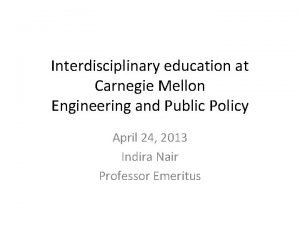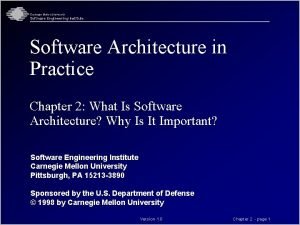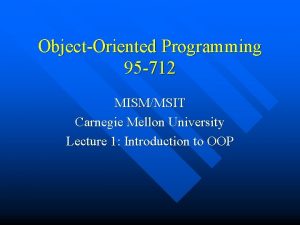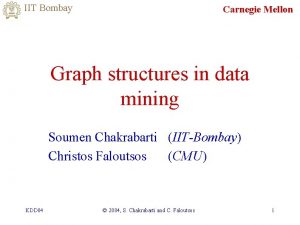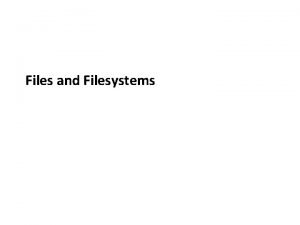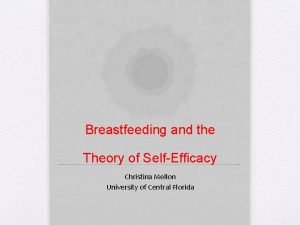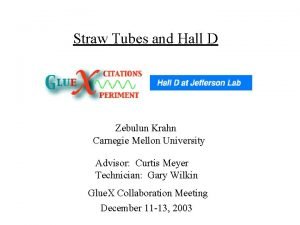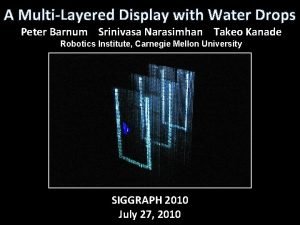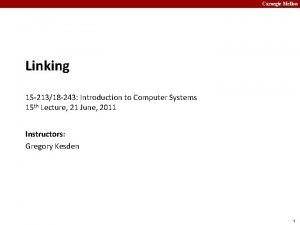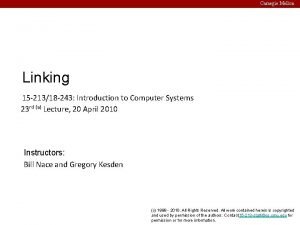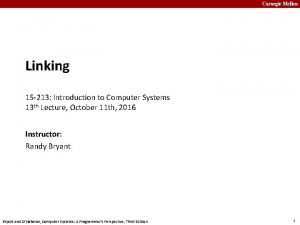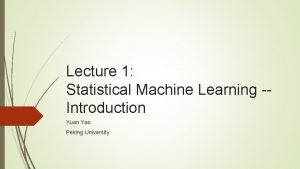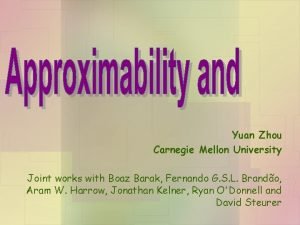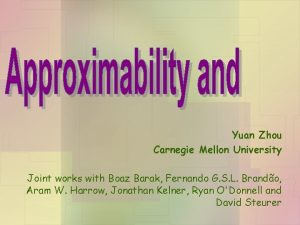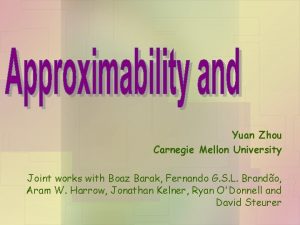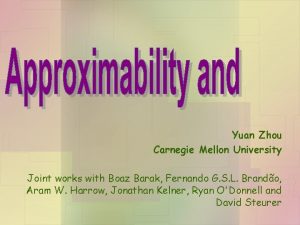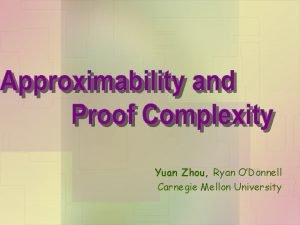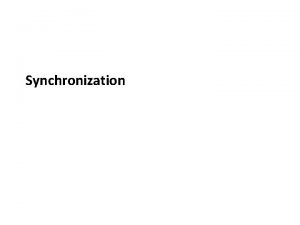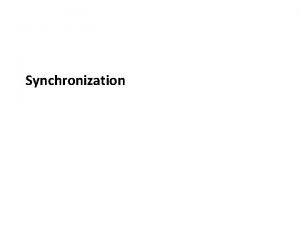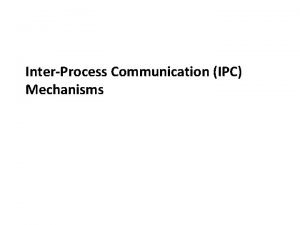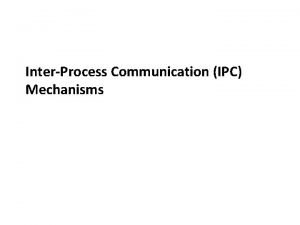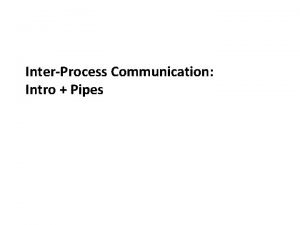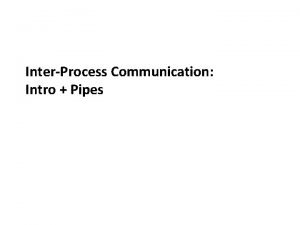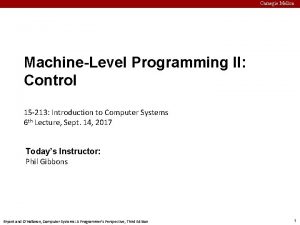Yuan Zhou Carnegie Mellon University Joint works with


























![Remarks • Positivestellensatz. [Krivine'64, Stengle'73] If the given equalities & inequalities are infeasible, there Remarks • Positivestellensatz. [Krivine'64, Stengle'73] If the given equalities & inequalities are infeasible, there](https://slidetodoc.com/presentation_image_h2/d6f281d1bbd22eda4da02e11580ce24c/image-27.jpg)











- Slides: 38

Yuan Zhou Carnegie Mellon University Joint works with Boaz Barak, Fernando G. S. L. Brandão, Aram W. Harrow, Jonathan Kelner, Ryan O'Donnell and David Steurer

Constraint Satisfaction Problems • Given: – a set of variables: V – a set of values: Ω – a set of "local constraints": E • Goal: find an assignment σ : V -> Ω to maximize #satisfied constraints in E • α-approximation algorithm: always outputs a solution of value at least α*OPT

Example 1: Max-Cut • Vertex set: V = {1, 2, 3, . . . , n} • Value set: Ω = {0, 1} • Typical local constraint: (i, j) э E wants σ(i) ≠ σ(j) • Alternative description: – Given G = (V, E), divide V into two parts, – to maximize #edges across the cut • Best approx. alg. : 0. 878 -approx. [GW'95] • Best NP-hardness: 0. 941 [Has'01, TSSW'00]

Example 2: Balanced Seperator • Vertex set: V = {1, 2, 3, . . . , n} • Value set: Ω = {0, 1} • Minimize #satisfied local constraints: (i, j) э E : σ(i) ≠ σ(j) • Global constraint: n/3 ≤ |{i : σ(i) = 0}| ≤ 2 n/3 • Alternative description: – given G = (V, E) – divide V into two "balanced" parts, – to minimize #edges across the cut

Example 2: Balanced Seperator (cont'd) • Vertex set: V = {1, 2, 3, . . . , n} • Value set: Ω = {0, 1} • Minimize #satisfied local constraints: (i, j) э E : σ(i) ≠ σ(j) • Global constraint: n/3 ≤ |{i : σ(i) = 0}| ≤ 2 n/3 • Best approx. alg. : sqrt{log n}-approx. [ARV'04] • Only (1+ε)-approx. alg. is ruled out even assuming 3 -SAT does not have subexp time alg. [AMS'07]

Example 3: Unique Games • Vertex set: V = {1, 2, 3, . . . , n} • Value set: Ω = {0, 1, 2, . . . , q - 1} • Maximize #satisfied local constraints: (i, j) э E : σ(i) - σ(j) = c (mod q) • Unique Games Conjecture (UGC) [Kho'02, KKMO'07] No poly-time algorithm, given an instance where optimal solution satisfies (1 -ε) constraints, finds a solution satisfying ε constraints • Stronger than (implies) "no constant approx. alg. "

Example 3: Unique Games (cont'd) • Vertex set: V = {1, 2, 3, . . . , n} • Value set: Ω = {0, 1, 2, . . . , q - 1} • Maximize #satisfied local constraints: (i, j) э E : σ(i) - σ(j) = c (mod q) • UG(ε): to tell whether an instance has a solution satisfying (1 -ε) constraints, or no solution satisfying ε constraints • Unique Games Conjecture (UGC). UG(ε) is hard for sufficiently large q

Example 3: Unique Games (cont'd) • Implications of UGC – For large class of problems, BASIC-SDP (semidefinite programming relaxation) achieves optimal approximation ratio Max-Cut: 0. 878 -approx. Vertex-Cover: 2 -approx. Max-CSP [KKMO '07, MOO '10, KV '03, Rag '08]

Open questions • Is UGC true? • Are the implications of UGC true? – Is Max-Cut hard to approximate better than 0. 878? – Is Balanced Seperator hard to approximate with in constant factor?

SDP Relaxation hierarchies • A systematic way to write tighter and tighter SDP relaxations BASIC-SDP rounds SDP relaxation in roughly time ? … UG(ε) ARV SDP for Balanced Seperator GW SDP for Maxcut (0. 878 -approx. ) • Examples – Sherali-Adams+SDP [SA'90] – Lasserre hierarchy [Par'00, Las'01]

How many rounds of tighening suffice? • Upperbounds – rounds of SA+SDP suffice for UG(ε) [ABS'10, BRS'11] • Lowerbounds [KV'05, DKSV'06, RS'09, BGHMRS '12] (also known as constructing integrality gap instances) – – for UG(ε) rounds of SA+SDP needed for better-than-0. 878 approx for Max-Cut – rounds for SA+SDP needed for constant approx. for Balanced Seperator

Our Results • We study the performance of Lasserre SDP hierarchy against known lowerbound instances for SA+SDP hierarchy, and show that • 8 -round Lasserre solves the Unique Games lowerbound instances [BBHKSZ'12] • 4 -round Lasserre solves the Balanced Seperator lowerbound instances [OZ'12] • Constant-round Lasserre gives better-than 0. 878 approximation for Max-Cut lowerbound instances [OZ'12]

Proof overview • Integrality gap instance – SDP completeness: a good vector solution – Integral soundness: no good integral solution • A common method to construct gaps (e. g. [RS'09]) – Use the instance derived from a hardness reduction – Lift the completeness proof to vector world – Use the soundness proof directly

Proof overview (cont'd) • Our goal: to prove there is no good vector solution – Rounding algorithms? • Instead, – we bound the value of the dual of the SDP – interpret the dual of the SDP as a proof system ("Sum-of-squares proof system") – lift the soundness proof to the proof system

Remarks • Connection between SDP hierarchies and algebraic proof systems • New insight in designing integrality gap instances – should avoid soundness proofs that can be lifted to Sum-of-Squares proof system • Lasserre is strictly stronger than other hierarchies on UG and related problems (as it was believed to be)

Outline of the rest of the talk Sum-of-Squares proof system Relation between So. S proof system and Lasserre SDP hierarchy Lift the soundness proofs to the So. S proof system

Sum-of-Squares proof system

Polynomial optimization • Maximize/Minimize • Subject to all functions are low-degree n-variate polynomial functions • Max-Cut example: Maximize s. t.

Polynomial optimization (cont'd) • Maximize/Minimize • Subject to all functions are low-degree n-variate polynomial functions • Balanced Seperator example: Minimize s. t.

Certifying no good solution • Maximize • Subject to • To certify that there is no solution better than , simply say that the following equations & inequalities are infeasible

The Sum-of-Squares proof system • To show the following equations & inequalities are infeasible, • Show that • where is a sum of squared polynomials, including 's • A degree-d "Sum-of-Squares" refutation, where

Example 1 • To refute • We simply write • A degree-2 So. S refutation

Example 2: Max-Cut on triangle graph • To refute • We "simply" write. . .

Example 2: Max-Cut on triangle graph (cont'd) • A degree-4 So. S refutation

Relation between So. S proof system and Lasserre SDP hierarchy

Finding So. S refutation by SDP • A degree-d So. S refutation corresponds to solution of an SDP with variables • The SDP is the same as the dual of -round Lasserre relaxation Bounding SDP value by So. S refutation • An So. S refutation => upperbound on the dual of optimum of Lasserre => upperbound on the value of Lasserre – e. g. 4 -round Lasserre says that Max-Cut of the triangle graph is at most 2 (BASIC-SDP gives 9/4)
![Remarks Positivestellensatz Krivine64 Stengle73 If the given equalities inequalities are infeasible there Remarks • Positivestellensatz. [Krivine'64, Stengle'73] If the given equalities & inequalities are infeasible, there](https://slidetodoc.com/presentation_image_h2/d6f281d1bbd22eda4da02e11580ce24c/image-27.jpg)
Remarks • Positivestellensatz. [Krivine'64, Stengle'73] If the given equalities & inequalities are infeasible, there is always an So. S refutation (degree not bounded). • The degree-d So. S proof system was first proposed by Grigoriev and Vorobjov in 1999 • Grigoriev showed degree is needed to refute unsatisfiable sparse -linear equations – later rediscovered by Schoenbeck in Lasserre world

Lift the proofs to So. S proof system

Unique Games

Components of the soundness proof (of known UG instances) • • • Cauchy-Schwarz/Hölder's inequality Hypercontractivity inequality Smallsets expand in the noisy hypercube Invariance Principle Influence decoding

Hypercontractivity Inequality • 2 ->4 hypercontractivity inequality: for low degree polynomial we have • Goal of an So. S proof: write Note that 's are indeterminates

Hypercontractivity Inequality (cont'd) • 2 ->4 hypercontractivity inequality: for low degree polynomial we have • Goal of an So. S proof: write • Prove by induction (very similar to the wellknown inductive proof of the inequality itself). . .

Components of the soundness proof (of known UG instances) • • • Cauchy-Schwarz/Hölder's inequality Hypercontractivity inequality Smallsets expand in the noisy hypercube Invariance Principle Influence decoding

A few words on Invariance Principle • trickier • "bump function" is used in the original proof --- not a polynomial! • but. . . a polynomial substitution is enough for UG

Max-Cut and Balanced Seperator • An So. S proof for "Majority Is Stablest" theorem is needed for Max-Cut instances – We don't know how to get around the bump function issue in the invariance step – Instead, we proved a weaker theorem: "2/pi theorem" -- suffices to give better-than 0. 878 algorithms for known Max-Cut instances • Balanced Seperator. Key is to So. S-ize the proof for KKL theorem – Hypercontractivity and SSE is also useful there – Some more issues to be handled

Summary • So. S/Lasserre hierarchy refutes all known UG instances and Balanced Seperator instances, gives better-than-0. 878 approximation for known Max. Cut instances, – certain types of soundness proof does not work for showing a gap of So. S/Lasserre hierarchy

Open problems • Show that So. S/Lasserre hierarchy fully refutes Max-Cut instances? – So. S-ize Majority Is Stablest theorem. . . • More lowerbound instances for So. S/Lasserre hierarchy?

Thank you!
 Carnegie mellon university research participants
Carnegie mellon university research participants Comp bio cmu
Comp bio cmu Carnegie mellon interdisciplinary
Carnegie mellon interdisciplinary Carnegie mellon software architecture
Carnegie mellon software architecture Cmu bomb threat
Cmu bomb threat Carnegie mellon software architecture
Carnegie mellon software architecture Cmu mism
Cmu mism Randy pausch time management slides
Randy pausch time management slides Robotic ankle
Robotic ankle Carnegie mellon
Carnegie mellon Carnegie mellon
Carnegie mellon Cmu vpn
Cmu vpn Carnegie mellon
Carnegie mellon Carnegie mellon
Carnegie mellon Carnegie mellon
Carnegie mellon Frax
Frax Carnegie mellon fat letter
Carnegie mellon fat letter Carnegie mellon
Carnegie mellon Cmu bomb lab
Cmu bomb lab Street works revision
Street works revision Mellon serbia iskustva
Mellon serbia iskustva Carneigh mellon
Carneigh mellon Christina mellon
Christina mellon Wageworks health equity
Wageworks health equity Zebulun krahn
Zebulun krahn Water mellon
Water mellon Mellon elf
Mellon elf Mellon elf
Mellon elf Mellon elf
Mellon elf Yuan-pern lee
Yuan-pern lee Model yuan yao
Model yuan yao Feng yuan microsoft
Feng yuan microsoft Dinastiyang xia tagalog
Dinastiyang xia tagalog Yuan yao math
Yuan yao math Yuan dynasty accomplishments
Yuan dynasty accomplishments Origins of taoism
Origins of taoism General yuan shigai
General yuan shigai Liao yuan
Liao yuan Ding yuan toronto
Ding yuan toronto


